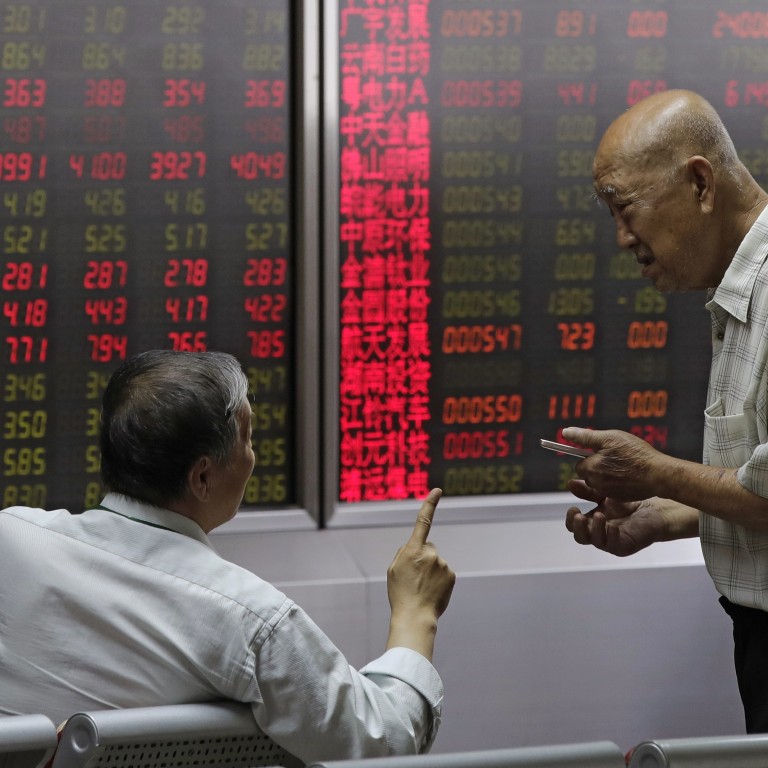
Flagging China and Hong Kong markets clip early losses as pharmaceutical and property shares surge
- Xiaomi continues its tumble after media report that investor sold 231 million class B shares
- Beaten-down pharmaceuticals surge after positive analyst note
Hong Kong and mainland China benchmarks kept early losses in check Wednesday, as another wretched day for smartphone maker Xiaomi and smartphone suppliers was offset by big gains for pharmaceuticals and property developers.
In addition, a fresh step by Beijing to pump more cash into the economy boosted traders’ moods.
The Hang Seng Index dropped as much as 0.8 per cent before rising up to close 0.3 per cent, or 71.81 points, higher at 26,902.1, extending a 2 per cent rally from Tuesday. The Shanghai Composite Index bobbed between gains and losses and closed little changed at 2,570.42.
“The market is focusing more on positive factors such as China’s willingness to ratchet up its support for the economy instead of negative ones,” said Castor Pang Wai-sun, Core Pacific-Yamaichi’s head of research, noting as negatives the UK parliament’s rejection of Theresa May’s Brexit deal and uncertainties about US-China trade talks.
China’s central bank injected a record 560 billion yuan (US$83 billion) into the markets through reverse repo operations on Wednesday, a day after top economic planners vowed supportive measures including large-scale tax cuts.
The move to boost liquidity arrived three weeks ahead of the Lunar New Year, when cash demand traditionally surges. The central bank implied on Tuesday it would evaluate whether to cut interest rates after assessing the effect of current policies on shoring up the slowing economy.
A drag in Hong Kong was Chinese smartphone and home appliances maker Xiaomi, which fell 2.6 per cent to HK$9.7, on the back of a Bloomberg report that an investor sold 231 million class B shares at HK$9.45 per share.
The much-watched new economy stock has been on a downward spiral in Hong Kong since major investors were allowed to sell their shares last Wednesday, when a lock-up period expired following the company’s debut. The shares have sunk by 24 per cent since the beginning of last week.
Other smartphone component suppliers took a beating too, amid worrying signs including Apple’s warning of slower China growth and the projection of a 19 per cent drop in global smartphone output by Credit Suisse. AAC Technologies fell 3.4 per cent and Sunny Optical declined 2.2 per cent.
“There’s no need to look at the smartphone and smartphone component sector any more. New functions are unlikely to come out before 5G is introduced in 2020, so sales won’t be good,” said Pang.
“Valuations of the suppliers were pushed up too high previously and now investors are pounding them given the profit warning.”
In China, leading LED chip maker Sanan Optoelectronics sank by the 10 per cent daily limit after media reports questioned the authenticity of its financial records.
A surge in Chinese pharmaceutical stocks lent support to the market. Reports from Morgan Stanley and Citibank suggested the market has underestimated valuations of the stocks, amid signs of more accommodating government practises in a new procurement process that previously had beaten down drug makers.
Sino Biopharm jumped 7.1 per cent and CSPC Pharmaceutical Group surged 5.4 per cent.
Chinese insurers also rose after reporting a rise in premium revenue. China Life Insurance Company advanced 4.8 per cent on the back of a 4.7 per cent increase in last year’s revenue, and New China Life rose 1.2 per cent on a 12 per cent expansion in premium income.
Mainland Chinese developers jumped after the latest official reading of China’s new home prices indicated prices remained resilient in spite of government cooling measures.
New home prices grew faster in megacities such as Beijing – which saw a 1 per cent rise in new home prices against 0.6 per cent in November.
Country Garden, which had the highest turnover, surged 3.5 per cent. Sunac China Holdings added 2.3 per cent and China Evergrande rose 1.8 per cent.

